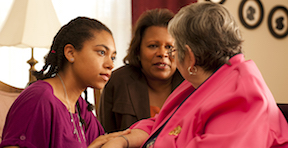Difference between revisions of "Ministering"
(Created page with "300px|thumb|frame|Courtesy of LDS.org|right ‘’’Ministering’’’ is the name given to the effort by members of [http://Mormon.org The Churc...") |
(No difference)
|
Revision as of 14:12, 16 October 2018
‘’’Ministering’’’ is the name given to the effort by members of The Church of Jesus Christ of Latter-day Saints to follow the pattern set by the Lord Jesus Christ to serve and love each other.
Jesus’s life and ministry exemplify the two great commandments: “Thou shalt love the Lord thy God with all thy heart, and with all thy soul, and with all thy mind” and “Thou shalt love thy neighbour as thyself” (Matthew 22:37, 39).[1]
During the Sunday afternoon session of April general conference, President Russell M. Nelson announced a significant change to the way members would serve and care for each other.
The separate programs of home teaching and visiting teaching were “retired” and a coordinated effort called “ministering,” a “new and holier approach” to Christlike caring for others and helping meet their spiritual and temporal needs was introduced.
President Russell M. Nelson’s introductory message was brief:
- Dear brothers and sisters, we constantly seek direction from the Lord on how we can help our members keep the commandments of God, especially those two great commandments to love God and our neighbors.1
- For months we have been seeking a better way to minister to the spiritual and temporal needs of our people in the Savior’s way.
We have made the decision to retire home teaching and visiting teaching as we have known them. Instead, we will implement a newer, holier approach to caring for and ministering to others. We will refer to these efforts simply as “ministering.”
- Effective ministering efforts are enabled by the innate gifts of the sisters and by the incomparable power of the priesthood. We all need such protection from the cunning wiles of the adversary.
Elder Jeffrey R. Holland of the Quorum of the Twelve Apostles and Sister Jean B. Bingham, General President of the Relief Society, will explain how assigned brethren of the priesthood and assigned sisters of the Relief Society and Young Women will now function in serving and watching over members of the Church throughout the world.
- The First Presidency and the Twelve are united in endorsing their messages. Gratefully and prayerfully we open this new chapter in the history of the Church. In the name of Jesus Christ, amen.
Under the ministering approach, elders quorum presidencies will assign ministering brothers to every household, and Relief Society presidencies will assign ministering sisters to each adult sister. Ministering brothers and sisters “will no longer report monthly visits, but will instead counsel with leaders in a quarterly ‘absolutely crucial’ ministering interview about the needs and strengths of those they are assigned. The number of interviews leaders had with ministering companionships during a quarter is the only formal report that will be made. However, the purpose of the interview, Elder Holland explained, is for priesthood and Relief Society leaders to understand the ‘spiritual and temporal condition of the people.’”[2]
- Ministering does not include a set monthly message [provided] in the Church magazines nor a prescribed way to keep in contact, such as in-home, face-to-face visits each month—even though visits are important when they are possible, the leaders explained.[3]
Sister Jean B. Bingham gave some examples of the flexibility needed to meet needs and circumstances of individuals throughout the world: “Ministering . . . looks like going for a walk, getting together for a game night, offering service, or even serving together. It looks like visiting in person or talking on the phone or chatting online or texting. It looks like delivering a birthday card and cheering at a soccer game. It looks like sharing a scripture or quote from a conference talk that would be meaningful to that individual. It looks like discussing a gospel question and sharing testimony to bring clarity and peace. It looks like becoming part of someone’s life and caring about him or her. It also looks like a ministering interview in which needs and strengths are discussed sensitively and appropriately. It looks like the ward council organizing to respond to a larger need.” [4]
“With these adjustments we want more care and concern, not less,” Elder Holland cautioned.[5]
Sister Bingham also explained that ministering may include Young Women (Laurels and Mia Maids, ages 14 to 18) as companions to Relief Society sisters, and priests and teachers continue to serve as ministering companions to Melchizedek Priesthood holders.
